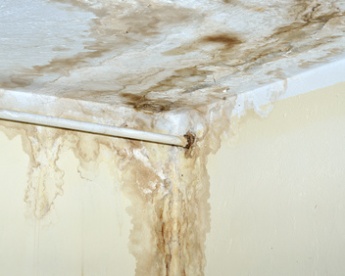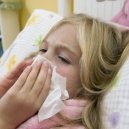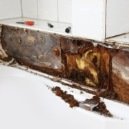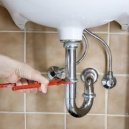Find a pre-screened local mold removal specialist Free Estimate
Find a Mold Specialist Now
Click or Call, Toll-Free 24/7
Fusarium Mold in the Home
Fusarium mold can be a highly dangerous mold that typically affects soil and plants. It can cause a range of infections in humans and has even been used as an agent of biological warfare. There are many varieties of this mold, and it can appear pale or brightly colored, with a cottony surface. The color can range from white to yellow, brown, pink or yellow.
In the garden or greenhouse, fusarium can affect tomatoes, tobacco, legumes, sweet potatoes and bananas. Billions of dollars of barley and wheat crops in the U.S. have been lost to root rot and seedling blight caused by this mold. In the home, it can grow on drywall, carpets, wood flooring and many other surfaces that have suffered water damage.
Health Issues Caused by Fusarium Mold
All molds have the potential to be allergens. People sensitive or allergic to molds may experience flu-like symptoms, including nasal and sinus congestion, sore throat, itchy, watery eyes and asthma symptoms like wheezing and coughing. Extended exposure to mold spores in the home can increase the symptoms. Only removing the mold from the home can provide permanent relief.
Fusarium mold can cause opportunistic infections in healthy people, including onychomycosis which is a nail infection, and keratomycosis, an infection of the cornea. Untreated infections can cause permanent scarring and vision loss. For people with compromised immune systems, more aggressive systemic infections can occur. The mold spores are usually inhaled, but can also reach the bloodstream through cuts or burns in the skin.
A form of this mold is produced industrially as a human food known as Quorn. It has the potential to cause allergic reactions similar to peanut allergies. People with mold allergies may be at higher risk for allergic reactions when consuming it.
Fusarium mold was discovered to be potentially useful as a biological weapon when, in the 1930s and 40s, mold-contaminated wheat flour was baked into bread in the Soviet Union. Sixty percent of the victims died of alimentary toxic aleukia. After the cause of the outbreak was discovered, the mold-based mycotoxin was weaponized. Although its use has been banned by the Biological Weapons Convention, fusarium has been the source of a variety of outbreaks of infectious diseases and its use and safety are still under study and debate.
What To Do If You Find Fusarium Mold?
All mold in the home poses some degree of risk, both to your health and to the structure of your home. Although it doesn’t become airborne unless the mold is completely dry, fusarium mold grows quickly in damp environments. Water damage due to flooding, broken pipes or sewage backups in your home can create an ideal setting for mold growth, but even a slow, unseen leak behind the walls can cause major damage.
 Mold from roof leak
Mold from roof leakIf you suspect you have this or any type of mold growing in your home, you need to get rid of it promptly. You also need to eliminate the cause of the moisture problem. Basic home maintenance can make a big difference with preventing mold.
Always clean up water spills immediately, and repair plumbing leaks promptly. Make sure your bathrooms and kitchen are vented outdoors, and run the fans while showering and cooking so moisture doesn’t build up inside. During damp, rainy months and during the summer, use a de-humidifier or air conditioner to maintain indoor humidity levels between 30 and 50 percent. Check windows for signs of condensation. You may need to replace the window insulation or have new windows installed.
Removing Mold
Prevent expensive and extensive damage to your home by carefully removing existing mold. For surface mold or a smaller amounts of mold, you may decide that you can remove it yourself. The U.S. Environmental Protection Agency (EPA) suggests that 10 square feet of mold or smaller can usually be cleaned by a homeowner.
Be cautious about tackling any mold removal project if you suffer from allergies, have respiratory or other health problems, or are at all concerned about your health due to mold exposure. A professional mold remediation specialist can perform this work for you safely to minimize the health risks to you and other members of your household.
Before you proceed, you need to have the proper equipment. You’ll need gloves, goggles and a mold-approved mask or respirator to protect yourself from breathing in mold spores. You can follow this link to learn more about personal protection. You’ll also need to seal off the damaged area with tape and plastic sheeting to prevent the mold from spreading. To clean mold from nonporous surfaces, use a vacuum with a HEPA-filter, and an antimicrobial cleaning solution. Porous surfaces including carpet, fabric, sheetrock, insulation and wood will likely need to be replaced.
The EPA advises contacting a professional if your mold issue was caused by a large amount of water damage, or if there is more than ten square feet of mold. You should also consult a professional if the mold is growing in your home’s HVAC (heating, ventilation, and air conditioning) system. Additionally, if your mold issue is the result of a flood or a sewage backup, you’ll want to use a professional to make sure all the mold is safely removed.
The best thing to do if you find mold in your home is to contact a mold removal professional. Mold removal specialists offer free home inspections, so even if you are thinking of removing the mold yourself, you can still get some free professional advice. If there is more mold than you realized, or the job is more complex than you thought, you are probably better off letting a professional remove the mold for you. Mold removal can be a much more involved process than most homeowners realize. You can use this link to get a list of mold professionals in your area that offer free home assessments.
Return From Fusarium Mold To Our Types Of Mold Page
Ref:
EPA - Mold Cleanup in your Home
Free Home Inspection By A Mold Removal Specialist
Search This Website
 Fusarium Mold
Fusarium MoldRecent Articles
-
See Our 5 Recommended Mold Removal Companies in Covington, KY
Apr 16, 25 12:59 PM
-
See Our 5 Recommended Mold Removal Companies in Wheaton, IL
Jun 20, 24 10:33 AM
-
See Our 5 Recommended Mold Removal Companies in Aberdeen, SD
Oct 08, 21 04:05 PM




